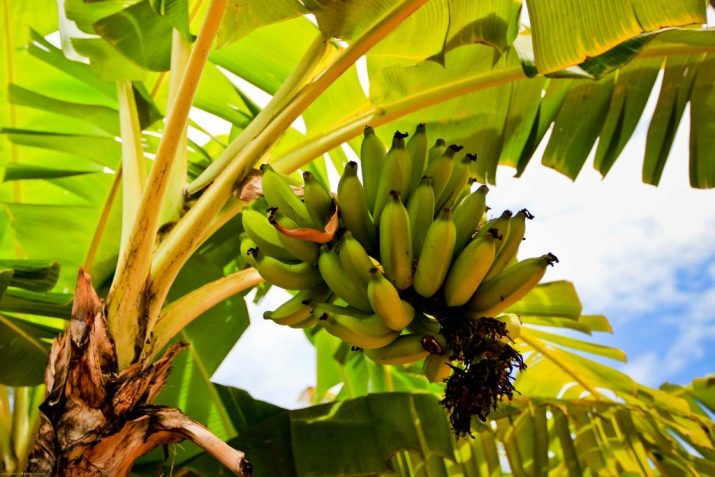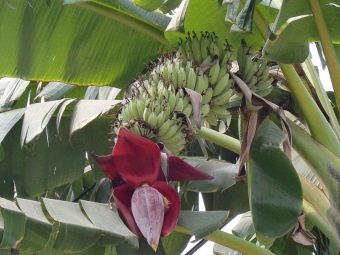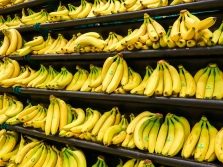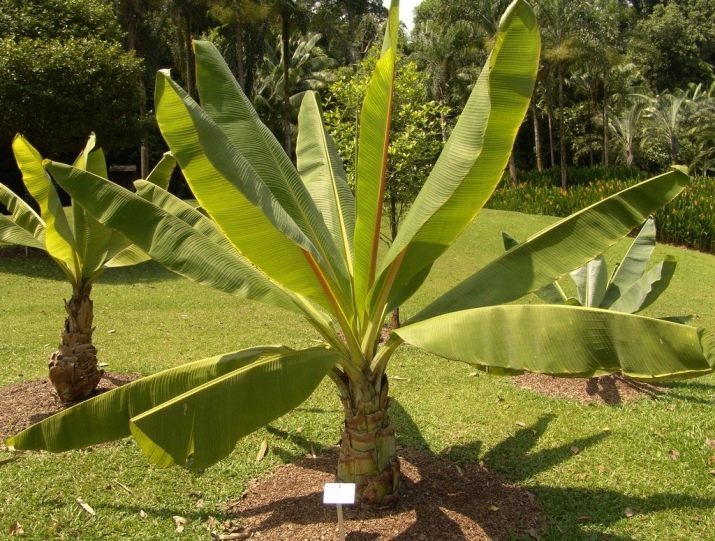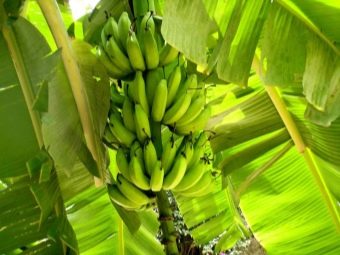Banana "tree": what is this plant, do bananas grow on a palm tree?
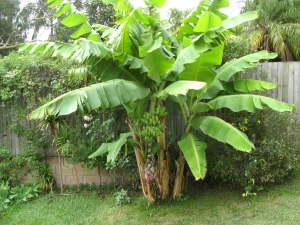
Bananas for the domestic buyer have long ceased to be an exotic fruit, as they are democratic and affordable.Let us consider in more detail how correctly to call bananas fruit, how they grow, and what types exist.
What is this plant?
Banana is a herbaceous plant on which fruits of the same name ripen. Despite the fact that the plant looks like a tree, it is grass. And it is quite high, the second highest after bamboo.
Banana grass is called due to the lack of wood on the aboveground part of the plant. In fact, the trunk (more correctly to say "false trunk") form exactly the leaves, superimposed on each other. It is not surprising that in this case it does not have growth rings and branches. Over time, the banana leaves that form the trunk dry up, get a brown tint and more and more, indeed, resemble the trunk.
Grass belongs to the family of bananas, the genus banana. It has branched rhizomes that extend up to 5 m and can go 1-1.5 m deep into the soil. The banana is often called a tree because of its high false trunk, which reaches 2-12 m and has a diameter of up to 40 cm.
The banana also boasts impressive size of leaves - they reach 3 m in length and 1 m in width. These are “ovals” with a pronounced longitudinal vein and a lot of thinner veins extending from it.
By the way, during a strong wind the leaves burst through the veins, thereby reducing the pressure on them and bypassing the threat of tearing the plant from the ground by a strong gust of wind.
The color of the leaves can vary considerably depending on the plant variety. Grass is found with dark and light green leaves, sometimes scarlet spots are placed over the green color. There are varieties, which are characterized by two-colored leaves - at the bottom they are purple and bright green above.
These huge leaves from the outside have a waxy coating, which prevents excessive evaporation of moisture from the leaves. As they age, the leaves fall off, and in their place new ones appear from the trunk sinuses. On average, it takes a week to develop a new sheet.
Often a plant is called a banana palm, due to some external similarity of plants. However, this classification is erroneous - the banana has nothing in common with palm ones.
The place of growth of a banana is a territory with a tropical and subtropical climate. The world's largest suppliers of bananas are Pakistan, India, China, Thailand, Bangladesh, Brazil. Under natural conditions, it is also possible to grow a crop near Sochi, but the winter temperatures here are still too low for it.
To date, there are about 70 varieties of bananas, all of them can be attributed to one of three groups.
Decorative
These plants are cultivated not for the sake of fruits (they are inedible), but because of their attractive appearance, especially during the flowering period. In addition, the leaves and elements of the false trunk are used in industry - automobile seats and fishing tackle are made from them.
Among the most famous decorative varieties are the following:
- "Banana pointed" has beautiful dark green leaves with notches, thanks to which the leaf resembles a bird feather, in the conditions of a warm climate bears fruit, fruits can be eaten;
- Blue Burmese Banana it is distinguished by an attractive silvery-coated purple-green stem, rich green leaves and fruits with violet or blue skin.
Plantano
Bananas of this variety grow large, they are suitable for human consumption, but usually involve heat treatment. Such fruits are fried, baked, cooked in deep fat, dipped in batter. By the way, it is from these varieties of bananas that they prepare banana chips.
Since the fruits of platano are quite dense, they are subjected to heat treatment, but ripe peel can be consumed fresh. To do this, choose a platano with black skinned.
Unlike dessert bananas, platano has a denser, unsweetened flesh and dense skin. In addition to being eaten, they are raised as livestock feed.
In turn, the bananas of platano are divided into 4 groups - French, French horn-shaped, false horn-shaped and horn-shaped.
Dessert
Well-known in our country, bananas, which can often be found on the shelves of stores in fruit departments. They are consumed fresh, you can also dry and drain the pulp of such bananas.
Among the most famous dessert varieties are “Paradise”, “Gros-Michel”, “Ice-cream”. Miniature bananas are a variety of “Lady fingers” (the length of fruits is 10-12 cm).
How does it bloom and bears fruit?
The plant is demanding for temperature. The optimum daytime temperature varies between + 27-35 ° C, and the night-time should not fall below + 25-28 ° C. Even a short-term cooling spell can provoke not only the falling off of the inflorescences, but also the death of the whole plant.
Similar negative effects can cause a decrease in humidity. This can cause a banana to stop growing.
Optimal soil - fertile, slightly sour. Particular attention is paid to weed control, for which special formulations are used, they resort to soil mulching and the help of geese. These poultry actively eat weeds, but are indifferent to bananas.
Flowering grass occurs after 8-10 months of active growth. To this period, from the tuber, which is located underground, the flower spike penetrates, passing through the entire trunk. By the flowering phase, he throws out a complicated stalk, externally similar to a large bud. The color is purple, sometimes greenish.
In the lower part of the "buds" flowers are formed. They are located in several tiers. Top - the largest, female flowers, the second tier are smaller bisexual, and at the very bottom - male flowers, having the smallest size.
Despite the difference in size, all flowers have the same structure and include 3 tubular petals and sepal. In addition, distinguish erect and drooping inflorescences, which depends on the type of banana.
Pollination of female flowers occurs through insects, and this process does not stop even at night, because in the dark time the bats produce pollination. There are no problems with attracting insects and birds, pollinating mice to banana inflorescences - their nectar is very sweet and fragrant. Over time, when formed from the inflorescences of the ovary, the “bud” begins to look like a hand with many fingers.
As the fingers ripen, they turn into a well-known, slightly elongated fruit with yellow skin. However, at first it is green, and it turns yellow as it ripens. The size and appearance of the fruit varies and depends on the variety. In the process of aging, the flesh also changes - it acquires a creamy shade, softness, juiciness.
In terms of botany, the fruits of a banana plant are berries. This is due to the fact that inside the pulp there are seeds located in a random or ordered form. Seeds are absent in domesticated fruits, while in wild plants they are easy to detect. However, if you cut the flesh of a cultivated banana along, you will find small dark spots - these are the seeds.
One inflorescence can produce up to 700 bananas, the total mass of which can reach 70-80 kg. After the fruiting period is completed, and the crop is harvested from the plant, the false stem dies off, at the place of which a new one will appear.
On average, it takes 16-19 months from planting to harvest. During the period of fruiting, the stem of the plant is strengthened with the help of props so that it does not break under the weight of the crop. Harvesting begins in the period when the ripeness of bananas is 75%. They are cooled and proceed to transport. To preserve the freshness of the fruits, special conditions are necessary - an air-gas chamber with a temperature no higher than + 14 ° C. In such conditions, bananas are able to maintain freshness and their properties for up to 50 days.
How to reproduce?
In the wild, reproduction of bananas is carried out with the help of seeds.They are transported over long distances by animals that live nearby and eat bananas.
Since cultivated plants do not have stones (only dark spots indicate their presence in ancient times, which can be found on the cut of the pulp), their reproduction in this way is impossible. In this case, resort to vegetative propagation.
If we talk about reproduction at home, this is done by growing season or with the help of seeds. However, contrary to some sources, You can not grow a banana "tree", from the bone bought a banana. This will require varietal seeds. They have a dense skin, so first they are slightly rubbed and crumpled so that a sprout can break through the skin, and then they are soaked in water.
Dwarf species for growing at home
For cultivation at home, you should choose decorative mini-trees. It should be understood that even dwarf varieties reach a height of 1.5-2.5 m. In contrast to the wild and planted relatives, it is, of course, not much. But in a small apartment such plants can hardly be considered “dwarf”.
Dwarf bananas grow well in a greenhouse, winter garden, while lower super dwarfs are suitable for a home or apartment.
Bananas are planted at home, which produce a crop, while the height of the false trunk reaches 2-2.5 m. These include several varieties.
- "Cavendish dwarf." A compact plant that grows up to 1.5-2 m. When creating suitable conditions, it will delight you with a crop of dessert bananas, each is 12-25 cm long. The fruits have a well-known appearance - a bright yellow skin with dark spots. There is another kind of variety - "Cavendish super dwarf".
- "Kiev dwarf". Another cold-resistant variety, which gives edible fruits. The height of the plant reaches 1.7 m, and if this seems excessive to you, pay attention to its related variety “Super Dwarf”. The height of the latter is not more than 1 m.
Ornamental varieties do not give edible fruits, but they grow a little less than the described varieties - on average, their height is 1-1.5 m. These include several varieties.
- "Velvety". The plant forms a false trunk with a height of 1.5 m and a diameter of 7 cm. The saturated green leaves have a red border, elongated. The velvety banana is literally blooming all year long; this period can last for several months. The inflorescences are replaced by small fruits, which acquire a pinkish skin as they mature. During the period of technical maturity, the rind opens, exposing the creamy pulp with seeds. This variety can survive a short-term decrease in temperature.
- "Bright Red." A small variety of banana height, usually grows no more than 1 m, has bright green leaves and rich red buds, which makes it noticeable and elegant. The flowering period lasts up to 2-3 months.
- "Lavender". Small (up to 1.5 m plant) with bright green leaves. This variety acquires particular attractiveness during fruiting - beautiful lavender or purple fruits form at the site of the inflorescences. True, they are completely tasteless.
Among the varieties that are popular for home cultivation, you can also call the “Pygmy Blood Banana”, which received this name due to its leaf color - the upper part is traditionally green, the lower part is crimson.
Among the miniature varieties, we can distinguish those plants that have an interesting type of leaves and those that are especially attractive during flowering and fruiting. The latter include the variety "Pink Velvet". The plant is characterized by low growth (1.2-1.5 m) and beautiful pink inflorescences and fruits. The latter are very fragrant, but contain many seeds and taste unpleasant.
The Banana Scarlet variety demonstrates special beauty during flowering. The combination of bright green narrowed leaves and fragrant scarlet inflorescences will not leave anyone indifferent.
The Manna plant also produces beautiful scarlet inflorescences, with the height of the “tree” not exceeding 1.2 m.
You can choose not dwarf varieties, and the usual, but very slow-growing. For example, "Banana yellow." It pleases with attractive yellow inflorescences, which do not fall down for several months. But to get a harvest is unlikely, it is too difficult in the conditions of a private house and apartment to recreate suitable conditions.
For growing at home you can use seeds. In contrast to the vegetative method, the plant thus obtained will be more resistant and strong, but its growth will take more time, and it will not be possible to grow edible fruits.
If you want to grow edible fruits, pay attention to the vegetative method of plant reproduction. To do this, after the banana stem dies, a “bud” should be extracted from the ground, from which a new sprout will develop, and divide it into 2 parts. One part is sent to the old place of growth, the second is rooted in a new pot.
How to grow a banana at home, you can see in the next video.

